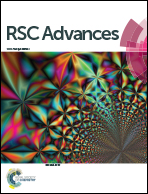Temperature dependent solubility of gold nanoparticle suspension/solutions
Abstract
We present measurements of the temperature dependence of thermally reversible solubility for a nanoparticle (NP) suspension/solution. The NPs were gold with an average diameter of 5.5 nm, ligated with dodecanethiol. The solvent was a toluene–dodecanethiol mixture. Analysis of the temperature dependence yielded an enthalpy of dissolution of ΔHd = 20.9 kJ per mole NP. Under the assumption that the NP superlattice solid that dissolves to yield the NP solution is a van der Waals solid, the implied melting temperature was found to be unrealistically high. However, under the same assumption, the minimum of the interparticle potential derived from the data agreed fairly well with a previously presented phenomenological model for the potential. Although the activity coefficient could not be determined due to the lack of a known melting temperature for the NP superlattice solid, any finite melting temperature implied a huge activity coefficient. Scatchard–Hildebrand theory cannot explain the data because the data extrapolate to negative temperatures at a NP mole fraction equal to one. However, the very large activity coefficient was ascribed to the very large molar volume of the NP system, consistent with that theory.


 Please wait while we load your content...
Please wait while we load your content...